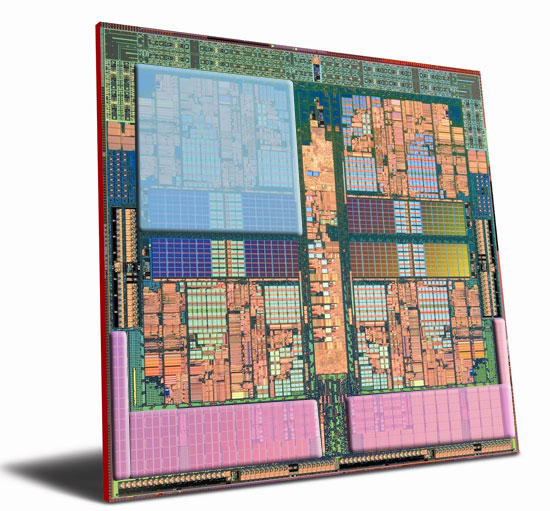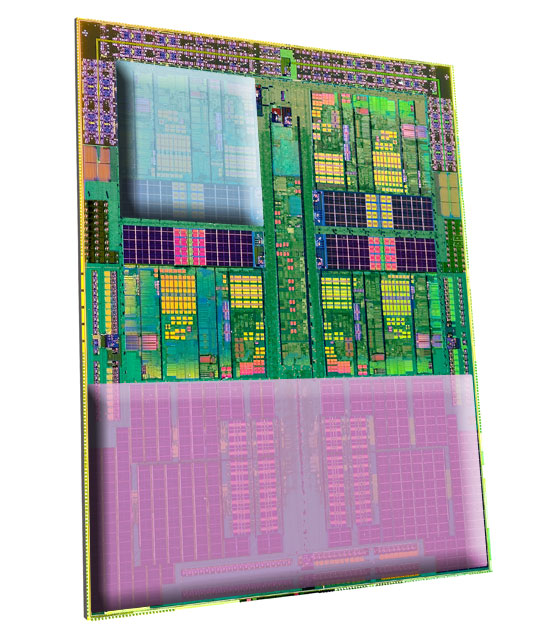AMD Phenom II X4 940 & 920: A True Return to Competition
by Anand Lal Shimpi on January 8, 2009 12:00 AM EST- Posted in
- CPUs
Phenom II's Secret, In Pictures
I can be verbose, I know, I'm sorry - I'm working on it. But on this page, I'll use pictures to illustrate my point. Here's the 65nm Phenom die:

I highlighted one of the four cores in blue. The bottom part of the highlighted core its its 512KB L2 cache. The areas in pink are the 2MB L3 cache that is shared by all four cores. Now look at Phenom II:

Again we've got one of the four cores highlighted blue. The L1 cache size and the core itself look very similar to the original Phenom, but note how the new die is much more rectangular. The pink area represents the Phenom II's 6MB L3 cache.
Just comparing the two die you can see that while the individual cores look similar, the amount of L3 cache has gone up considerably. Remember that Intel found with Nehalem that an 8MB L3 cache was the bare minimum, leaving 2MB per core. The original Phenom had 2MB to share amongst all four cores, which is hardly enough; Phenom II fixes that. With a 6MB L3 cache and 512KB L2 per core, Phenom II looks a lot more like Core i7 from a compute-to-cache ratio:

Nehalem's layout makes a little more sense, with each core butting up against the shared L3 cache, but the point is that in both Phenom II and Core i7, the L3 cache is around 1/3 of the total die. The original Phenom alloted only 1/6th of the die for its L3.










93 Comments
View All Comments
Proteusza - Thursday, January 8, 2009 - link
No, I said I hoped it could at least compete with a Core 2 Duo.if its too much to hope that a 2 year younger, 758 million transistor CPU could compete clock for clock with a first gen Core 2 Duo, then AMD has truly fallen to new lows. It has more transistors than i7, and yet it cant compete with a Core 2 Duo let alone i7. What happened to the sheer brilliance of the A64 days? It could beat the pants off any Pentium 4. Now the best AMD can do is barely acceptable performance at a higher clockspeed than Intel needs, all the while using a larger die than Intels.
This keeps them in the game, but it means I wont bother buying one. Why should I?
coldpower27 - Thursday, January 8, 2009 - link
Those days are over, their success was also contigent with Intel stumbling a bit and they did that with P4, with Intel firing on all cylinders, AMD at acceptable is just where they are supposed to be.Denithor - Thursday, January 8, 2009 - link
It wasn't so much of a stumble, more like a face-plant into a cactus. Wearing shorts and a tshirt.Intel fell flat with Netburst and refused to give up on it for far too long (Willamette -> Northwood -> Prescott -> Cedar Mill). I mean, the early days of P4 were horrible - it was outperformed by lower-clocked P3 chips until the increased clockspeed was finally too high for architectural differences to negate.
Into this mix AMD tossed a grenade, the A64 - followed by the X2 on the same architecture. With its IMC and superior architecture there was no way Netburst could compete. Unfortunately, AMD hasn't really done anything since then to follow through. And even today's PII isn't going to change things dramatically for them, they're still playing second fiddle to Intel's products (which means they're forced into following Intel's lead in the pricing game).
JKflipflop98 - Thursday, January 8, 2009 - link
Damn it feels good to be a gangsta ;)Kob - Thursday, January 8, 2009 - link
Thanks for the meaningful comparison with such a wide range of processors. However, I wonder why the benchmarks are so much tilted toward the graphics/gaming world. I think that many in the SOHO world will benefit from test results of other common applications/fields such as VS Compilation, AutoCAD manipulation, Encryption, simple database indexing and even a Chess game.ThePooBurner - Thursday, January 8, 2009 - link
In the article you compare this to the 4800 series of GPUs. I actually see this as the 3800 series. It works out perfectly. The 2900 came along way late and didn't deliver, used to much power, didn't overclock well, and was just all around a looser of a card. Then the 3800 came along. Basically the same thing, but with a die shrink that allowed it to outstretch, just enough, it's predecessor. It was the first card where they got the mix right. After that came the 4800 with a big boost and even more competition. This is what i now see happening with the CPU line. The Phenom 1 was the 2900, and the Phenom II is the 3800. Getting the mix right and getting ready for the next big swing. But, as you point out, Intel isn't likely to sit back, and we can all agree that they are a much different competitor than Nvidia is.Denithor - Thursday, January 8, 2009 - link
...and just like the 3800 series, it falls just short of the target.Remember? The 3870 couldn't quite catch the 8800GT and the 3850 couldn't quite match the 9600GT. While they weren't bad cards, they unfortunately also didn't give AMD the muscle to set pricing where they wanted it, instead they had to put pricing in line with how nVidia priced their offerings.
Same is happening here, with AMD pricing their chips in line with Intel's Q9400/Q9300 processors. And they may have to drop those prices if Intel cuts the Q9550/Q9400 down another peg.
Griswold - Friday, January 9, 2009 - link
Rubbish theory. First of all, these cards were actually available whereas the 8800GT was in extreme short supply and thus much more expensive for many weeks, even into 2008, because it literally made everything else nvidia had to offer obsolete. I couldnt get one and settled for a 3870 for that reason.Secondly, the 9600GT? Do you realize how much later that card came to the game than the 3850? It hit the market near the end of february. Thats almost 3 months after the launch of the 38xx part.
The whole comparison is silly.
ThePooBurner - Friday, January 9, 2009 - link
The 3800 line wasn't ever meant to beat the 8800 line. It just wasn't in the cards. It's purpose was to get the reins back under control. Cut the power and get back to a decent power/performance ratio as well as get equal power to a previous generation in a smaller package to help improve margins. It was a stage setter. From the first time i read about it i knew that it was just a setup for something more, something "bigger and better" that was going to come next. And then the 4800 came along and delivered the goods. I get this same feeling reading about the Phenom II. It's setting the stage. Getting about the same power (a small bump, just like the 3870 over the 2900) in a smaller package, a better power/performance ratio, etc.. This is simply a stage setting for the next big thing. The next CPU from AMD after this one is going to deliver. I'm sure of it.Kougar - Thursday, January 8, 2009 - link
If you tried Everest and Sandra, what about CPU-Z's cache latency tool? It's not part of the CPU-Z package anymore, but they still offer it. Link: http://www.cpuid.com/download/latency.zip">http://www.cpuid.com/download/latency.zipI thought this tool was very accurate, or is this not the case? It even detected the disabled L3 cache on a Northwood that turned out to be a rebadeged Gallatin CPU.